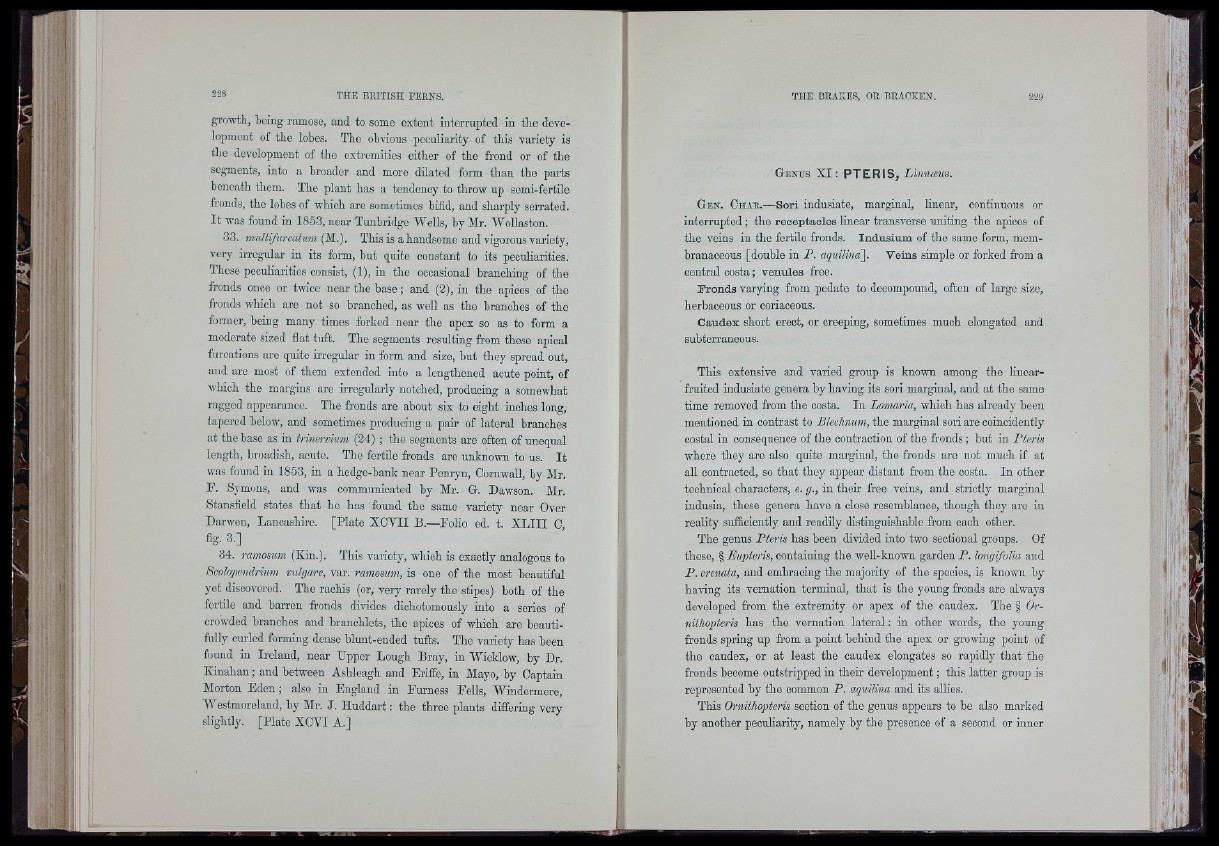
I !fl
* i 7 it • ‘i
f- i
ii( ,
i «1
■
I I P ' '!
growth, being ramose, and to some extent interrupted in the development
of the lobes. The obvious peculiarity of this variety is
the development of the extremities either of the frond or of the
segments, into a broader and more dilated form than the parts
beneath them. The plant has a tendency to throw up semi-fertile
fronds, the lobos of which are sometimes bifid, and sharply serrated.
It was found in 1853, near Tunbridge Wells, by Mr. Wollaston.
33. multifurcatum Qtl.). Tbis is a handsome and vigorous variety,
very irregular in its form, but quite constant to its peculiarities.
These peculiarities consist, (1), in tho occasional branching of the
fronds once or twice near the base; and (2), in the apices of the
fronds which are not so branched, as well as the branches of the
former, being many times forked near the apex so as to form a
moderate sized flat tuft. The segments resulting from these apical
furcations are quite irregular in form and size, hut they spread out,
and are most of them extended into a lengthened acute point, of
which the margins are irregularly notched, producing a somewhat
ragged appearance. The fronds are about six to eight inches long,
tapered below, and sometimes producing a pair of lateral branches
at the base as in trinervium (24) ; the segments are often of unequal
length, broadish, acute. The fertile fronds are unknown to us. It
was found in 1863, in a hedge-bank near Penryn, Cornwall, by Mr.
P. Symons, and was communicated by Mr. G. Dawson. Mr.
Stansfield states that he has found the same variety near Over
Darwen, Lancashire. [Plate XCVII B.—Folio ed. t. XLIII C
fig. 3.]
34. ramosum (Kin.). This variety, which is exactly analogous to
Scolopendrium mlgare, var. ramosum, is one of the most beautiful
yet discovered. The raehis (or, very rarely the stipes) both of the
fertile and barren fronds divides diohotomously into a series of
crowded branches and branchlets, the apices of which are beautifully
curled forming dense hlunt-ended tufts. The variety has been
found in Ireland, near Upper Lough Bray, in Wicklow, by Dr.
Kinahan; and between Ashleagh and Eriffe, in Mayo, by Captain
Morton Eden ; also in England in Eurness Fells, Windermere,
Westmoreland, by Mr. J. Huddart: the three plants differing very
slightly. [Plate XCVI A.]
Genus X I: PTERIS, Linnaius.
Íllti'í
' I lk
Gen. Chau.— Sori indusiate, marginal, linear, continuous or
interrupted; the receptacles linear transverse uniting the apices of
the veins in the fertile fronds. Indusium of the same form, membranaceous
[double in P . aquilina]. Veins simple or forked from a
central costa; venules free.
Fronds varying from pedate to decompound, often of large size,
herbaceous or coriaceous.
Caudex short erect, or creeping, sometimes much elongated and
subterraneous.
This extensive and varied group is known among the linear-
fruited indusiate genera by having its sori marginal, and at the same
time removed from the costa. In Lomaria, which has already been
mentioned in contrast to BUehnum, the marginal sori are ooincidently
costal in consequence of the contraction of the fronds; but in Pteris
where they are also quite marginal, the fronds are not much if at
all contracted, so that they appear distant from the oosta. In other
technical characters, e. g., in their free veins, and strictly marginal
indusia, these genera have a close resemblance, though they are in
reality sufficiently and readily distinguishahle from each other.
The genus Pteris has been divided into two sectional groups. Of
these, § Eupteris, containing the weU-known garden P . longifolia and
P. crenata, and embracing the majority of the species, is known by
having its vernation terminal, that is the young fronds are always
developed from the extremity or apex of the caudex. The § Or-
nithopteria has the vernation lateral: in other words, the young
fronds spring up from a point behind the apex or growing point of
the caudex, or at least the caudex elongates so rapidly that the
fronds become outstripped in their development; this latter group is
represented by the common P. aquilina and its allies.
This Orniihopteris section of the genus appears to he also marked
by another peculiarity, namely by the presence of a second or inner
( r
ff"
5!-,v
Í ; 1
|r 'S
:i;i
\¡M
: ill
Ill
Llh’
I,